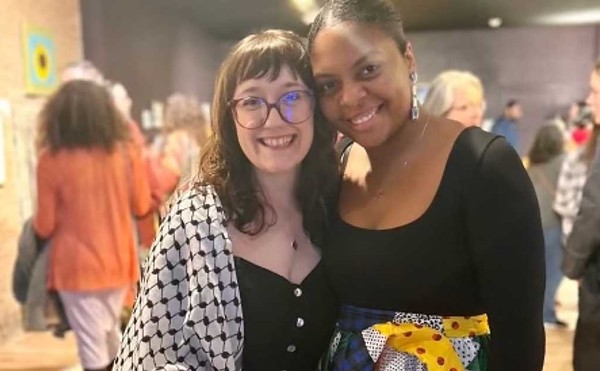Just blocks away from the dusty hole that was once the Hudson’s building, there’s a hipster loft that’s the unlikely home to one of Detroit’s hottest digital video innovators: Pilot Pictures, a partnership of graphic designer Rita Sayegh and visual artist Scott Stephanoff.
The location may seem odd – it’s not like downtown Detroit has a reputation for being an arts community. But with Pilot Pictures, Sayegh and Stephanoff are staking a claim for downtown Detroit’s artistic revival.
In doing so, they’re also breaking new ground in digital filmmaking, creating music videos and other projects that are putting this city on the electronic map.
Sayegh, 30, and Stephanoff, 28, came to digital video with a background in the arts. Both graduates of the Center for Creative Studies, Sayegh is the founder and owner of "Constructure," a design studio with clients ranging from techno artist Carl Craig to the Michigan Opera Theatre, while Stephanoff was the co-director of the Cement Space Gallery – he now works full time as a multimedia producer.
Pilot Pictures has built up plenty of momentum since its start in 1997. That, in part, is due to the medium of production: The affordable digital camera is revolutionizing the filmmaking industry.
While film production costs tend to be prohibitive, consumer-grade digital cameras can provide the necessary quality for training or promotional videos.
Editing digital video, in many ways, is like using a word processor. Instead of moving text, videographers cut, copy and paste images. The medium allows for more flexibility and experimentation than does film.
"The thing that I like about digital is it doesn’t have to be such a yes or no answer," Stephanoff says, adding that digital filmmakers aren’t bound by conventional approaches to either shooting or editing: "It’s all on the computer, you can drag and drop a sequence of clips."
And what does a digital video look like? Stephanoff answers, "It’s not film, it’s not video. It’s in its own category."
He also explains that it’s not all about the technology. In addition to pure technical ability, there is still a need for creativity. "To me it’s just another tool," Stephanoff remarks. "Like when the first table saw came out, or new printmaking techniques. You still have to have ideas behind it."
"It has to be good, no matter how you did it," Sayegh agrees. "If you’re going to see a digital movie or film, it’s still gotta be about the story when it’s done."
Pilot’s ability to be both creative and technologically progressive has brought them a number of clients, the majority of whom come to them to produce music videos.
"By virtue of being in Detroit, it’s mostly electronic and techno," says Stephanoff.
And the Internet has also played a key role in their rising success. When a friend mentioned Pilot on "313 Digest," an Internet site for fans of techno music, Sayegh and Stephanoff were amazed at the response. One day, they were primarily a local production company; the next, they were handling multiple requests for demos from all over the world.
"Detroit has such a great reputation everywhere else around the world for music, and especially electronic music," Stephanoff explains. "People really do follow things like that. They’ll just get in chat rooms, start talking, want to find out more about records, labels, DJs, and our name just kind of popped up. That’s the good thing about the Internet. Before that, how could that have happened so easily?"
Now, samples of Pilot’s projects are available on their Web site in streaming video format.
Pilot’s focus on electronic and techno music video projects has helped give them a signature
identity.
"I know for sure we’re not the only ones (doing digital video) in Detroit," says Sayegh, mentioning colleagues who work in animation or commercial projects. "We have a specific niche. There’s enough work in Detroit, so everyone seems to specialize."
As a result, Pilot Pictures maintains a strong commitment to Detroit, especially since the Web allows them to conduct business from here with the rest of the world.
Besides, Sayegh adds optimistically, "Detroit is getting some pats on the back. And that really helps."
Animated business
When John Schuchard first started doing animation, he recalls, "it wasn’t acceptable to do (animation) on your Mac."
That was a few years ago, when Schuchard was a photographer working with a traditional cell animator, and before people recognized how computer technology can aid creativity.
Today, Schuchard is a founding partner of brainCell Pictures, a digital animation company that started out in the back of a warehouse in Farmington. Now, with seven employees and two Detroit Emmy Awards to their credit, brainCell has relocated to a 2,500-square-foot space in Royal Oak where they continue to expand their horizons.
Today, brainCell does computer animation, specializing in 3-D animation and compositing (in which a composite, or collage, is made by cutting out different images and putting them into a scene), an approach brainCell frequently uses with its industrial projects. According to Schuchard, industrial clients tend to appreciate brainCell’s creativity.
"We’re solving different kinds of problems for them," he says. "As professionals, they give us more leeway." Examples of their work are available at www.bcell.com, a site offering downloadable animation clips from such recent projects as General Motors, Buick, Detroit Tigers and Detroit Public Television.
The people of brainCell Pictures also use Detroit artists in their work. When one recent project called for audio, they brought in local band the 19.5 Collective to compose original music.
"We’ve become known as a conduit," says Schuchard, who is clearly pleased with his ability to foster talent by independent artists. "I think there’s a real scene growing here in Detroit."





